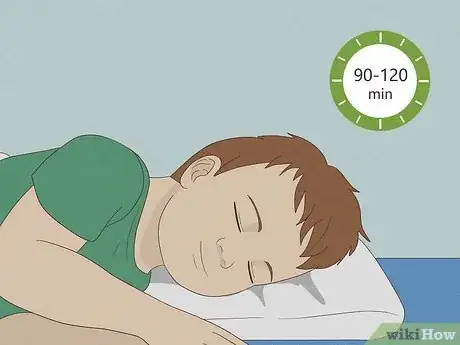This article was co-authored by wikiHow staff writer, Caroline Heiderscheit. Caroline Heiderscheit is a Staff Writer for wikiHow living in Santa Monica, CA. She has two years of experience working in content, including a year of editing work for first-time novelists. Caroline graduated from Stanford University in 2018 with degrees in American Studies and Creative Writing.
There are 7 references cited in this article, which can be found at the bottom of the page.
This article has been viewed 1,314 times.
Learn more...
You know the drill. Your toddler's up from a nap and they're acting groggy or angry or sleepy—how can you wake them up so they start the afternoon on the right foot? The answer is actually much simpler than you'd think. Below, we'll give you all the tips you need. Plus, we'll also talk more about how much your toddler should be sleeping, and how you can keep them snoozing overnight, too. Let's get started!
Steps
How should toddlers be woken up?
-
1Wake your toddler up at a set time each day. Not only should your little one go to bed at roughly the same time each afternoon or evening, but they should also be woken up at the same time, too. Routine is your friend, so for naps, set a stopwatch and wake them up when it goes off. Try these tips to find a solid sleep schedule:[1]
- Keep your toddler in their room: whether or not they're always actually asleep for their entire nap or nightly session, staying in their room will help solidify your toddler's schedule.
- Try a pre-sleep routine: A relaxing wind down session can work wonders. Before bed, lay with your toddler and sing lullabies or read with them. This'll set a natural, healthy sleep regiment, and over time, your routine will help them prepare to sleep.
- Make sure sleep happens in bed: the more routine and order you can bring to nap time and bedtime, the better. Stroller and car seat naps, for example, can throw them out of whack. Do your best to save sleeping for their bedroom!
-
2Use gentle lights and sounds to wake toddlers from a sleep. We’re all a little groggy and disgruntled when we’re woken up in harsh ways—toddlers are no different! Focus on waking them up gently and slowly. The key here is to make a little noise or let in a little light; that way, the toddler feels like they're waking up on their own terms.[2]
- Do light chores in their bedroom: quietly start putting away clothes and toys around their room. This can help them wake up in a slow, natural way.
- Climb into their bed: lay next to them, scratching their back or humming a tune. That way, they wake up peacefully, with their favorite person by their side.
- Open the blinds: gently open your child's window to let in some daylight. If they don't wake up in a couple minutes, gradually open them more and more.
- Sing a lullaby: enter your child's bedroom singing a soft tune. Over time, let your voice get a little louder to encourage them to wake up.
Dealing With a Tired, Cranky Toddler
-
1Show them that you're feeling positive, so they should too. Your mood will rub off on your child naturally. Even if they're crying or whining, do your best to wear a smile. Keep speaking to them in soothing voices and just generally, show them that even though they're in a bad headspace, their parent is not.
- On a related note, don't call out their bad mood. Saying things like "Wow, aren't you grumpy today!" might just encourage them to dig their heels in. Keep it positive instead!
-
2Create a stress-free morning routine. As mentioned, routines are everything. Who says you two need to get going right away? Help your toddler see that waking up isn't so bad. Make them a nice snack or breakfast and pull out their favorite toys so that they start off their morning right.[3]
- The key here is to keep the routine consistent and positive. You want your toddler to be able to expect similar wake-up schedules and on top of that, you want them to expect to have a nice, relaxing time.
-
3If all else fails, try a quick breathing exercise. We all need a reset sometimes—toddlers too! If your little one wakes up angry, take a moment and sit down across from them. Ask them to slowly breathe in with you, hold your breath, and then release it together. Breathing exercises are great for calming stress and battling overstimulation, so it can immediately improve your child's mood.[4]
- Plus, when your toddler is able to control their emotions through breathing exercises, they're self-regulating. This means that in the future, they'll feel more empowered to soothe themselves, too.
Tips to Help Your Toddler Sleep Through the Night
-
1Have your toddler nap less and earlier. Sometimes, your toddler’s nap schedule might take a little extra fine-tuning. Tweak your child’s nap time and length to promote better sleep through the night. For instance, try moving your child’s nap time up 30 minutes, then see if that makes them sleepier at night.
- Or, if you’re having your child sleep closer to 120 minutes, dial it back. Try waking them up at 90 minutes from here on out, and see if their nightly sleep improves.
-
2Set your child’s bedtime 30 minutes later at night. This one totally makes sense—when you go to sleep later, you’ll be sleepier at bedtime naturally. If your child is struggling to stay down overnight, try moving their bedtime 30 minutes later and then see if things improve.[5]
- The most important thing is that your toddler is getting enough sleep in a day. On the whole though, most parents put their toddlers down between 6 p.m. and 8 p.m. each night.
-
3Create an ideal environment for sleep. Toddlers need dark, cool, quiet rooms to have the best shot at a restful slumber. Does your house run hot? Do you leave the TV on a little too loud after bedtime? Small tweaks can make a huge difference in your toddlers sleep.[6]
- Clamping down curtains and unplugging nightlights can be a great way to turn your room pitch black.
- If you know your home is going to be a little noisy, try playing white noise for your toddler, so they're not too overstimulated to sleep.
- Then, make sure your thermostat shows ~65°F to 70°F (18°C to 22°C), because this'll make for perfect sleep conditions for your little one.
-
4Limit their screen time, especially right before bed. If your toddler plays around with phones and tablets (or, they like to watch TV), this can seriously disrupt their nighttime routine. To help your child sleep more soundly, limit their screen times and turn off all screens for an hour-long window prior to bedtime. Then, make sure that your toddler doesn't have screens available to them in their room—as this can be distracting.[7]
-
5Keep nighttime visits with your toddler quick. You know how it goes; your toddler cries, you check that they're okay, and suddenly, an hours gone by (and your toddler is more awake than when you first walked in). Check to make sure that your little one is safe and show your face so they know that you're just in the next room. Then, head back to your bedroom.[8]
- If you make your nighttime visits too exciting or too long, you might be accidentally training your toddler to stay up, so that they "earn" extra time with you. So in short, keep it short!
References
- ↑ https://www.parents.com/toddlers-preschoolers/sleep/naps/how-to-help-your-toddler-nap/
- ↑ https://www.fatherly.com/parenting/how-to-wake-up-a-kid-without-an-alarm
- ↑ https://www.kidspot.com.au/parenting/primary-school/kid-waking-up-cranky-heres-the-solution/news-story/94ada0fb41614c95fe3943e716334a9a
- ↑ https://www.kidspot.com.au/parenting/primary-school/kid-waking-up-cranky-heres-the-solution/news-story/94ada0fb41614c95fe3943e716334a9a
- ↑ https://www.babysleepscience.com/single-post/2014/04/08/early-vs-late-bedtime-which-is-right-how-to-use-early-and-late-bedtimes-to-solve-common-s
- ↑ https://healthcare.utah.edu/the-scope/shows.php?shows=0_7epla3ke
- ↑ https://kidshealth.org/en/parents/sleep12yr.html
- ↑ https://kidshealth.org/en/parents/sleep12yr.html
- ↑ https://raisingchildren.net.au/toddlers/sleep/understanding-sleep/toddler-sleep






































































